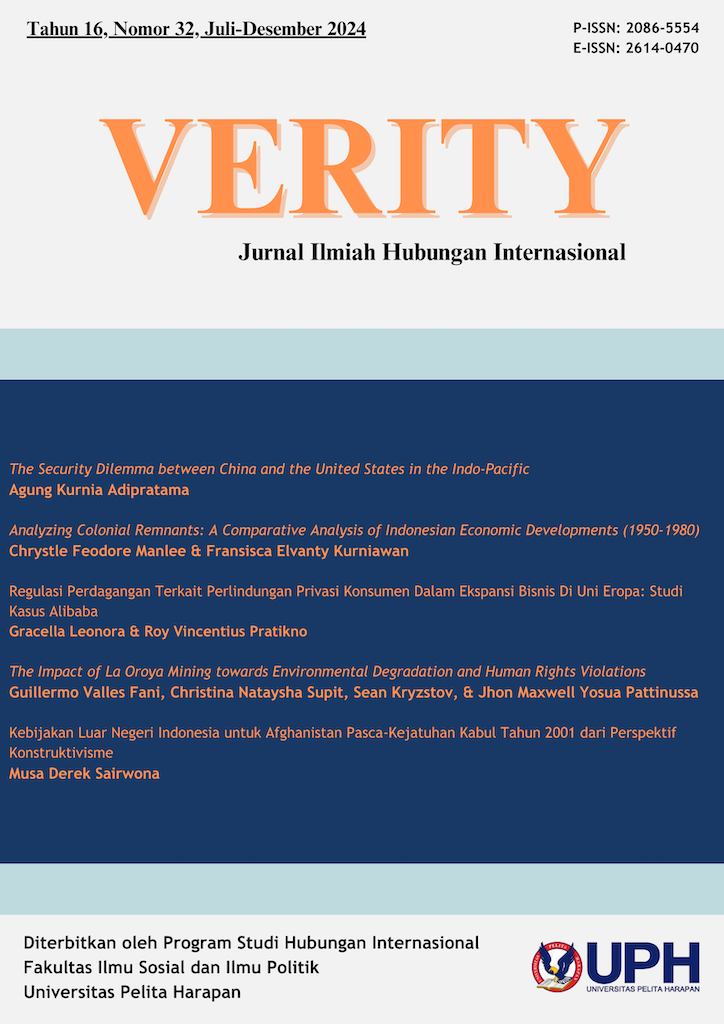THE IMPACT OF LA OROYA MINING TOWARDS ENVIRONMENTAL DEGRADATION AND HUMAN RIGHTS VIOLATIONS
DOI:
https://doi.org/10.19166/verity.v16i32.9100Schlagworte:
La Oroya, Mining, environemntal, Human Rights Violations, PeruAbstract
La Oroya Mining is an accurate example that environmental degradation and human rights violations can happen as a cause and effect. Mining in La Oroya Peru is very famous because it is one of Peru's largest sources of income and is its trademark. Meanwhile, this mining is also proof that Peru continues its imperialism. However, it cannot be denied that the effects of mining itself have had an impact on environmental degradation and human rights violations in local communities. This mining has caused worrying short-term and long-term impacts. In this paper, the authors and team try to analyze using qualitative methods through secondary data from journals. The aim is to find key factors that cause and impact this environmental degradation and human rights violation. The team authors also try to connect with three International Relations theories, which are realism, constructivism, and green political theory to look at it from three different points of view to find out the details. Further, the author also tries to trace what actions the Peruvian people have taken, the involvement of the IACHR in this problem as an international organization, the participation of NGOs, and how it continues. Furthermore, the role of the government will also be explored whether they help in solving this problem or make it worse and continue. Lastly, team authors try to propose effective solutions that can be implemented to help solve this environmental problem.
Literaturhinweise
American Convention on Human Rights: “Pact of San José, Costa Rica”. Signed at San José, Costa Rica, on 22 November 1969. (n.d.). Retrieved October 22, 2023, from https://treaties.un.org/doc/publication/unts/volume%201144/volume-1144-i-17955-en glish.pdf.
Custodio, M., Peñaloza, R., Orellana, E., Aguilar-Cáceres, M. A., & Oré, E. M. M. (2021). Heavy metals and arsenic in soil and cereal grains and potential human risk in the central region of Peru. Journal of Ecological Engineering, 22(1), 206–220. https://doi.org/10.12911/22998993/129255.
Dunne, T., Kurki, M., & Smith, S. (2010). International Relations Theories: Discipline and Diversity. Retrieved from http://lib.ui.ac.id/detail.jsp?id=20297087
Heywood, A. (2004). Politics. (5th Ed).
Hogenboom, B. (2015). European Review of Latin American and Caribbean Studies Revista Europea de Estudios Latinoamericanos y del Caribe. European Review of Latin American and Caribbean Studies / Revista Europea De Estudios Latinoamericanos Y Del Caribe, 143–151.
Kruijt, D., & Vellinga, M. (1977). The political economy of mining enclaves in Peru. Boletín De Estudios Latinoamericanos Y Del Caribe, 23, 97–126.
Lust, J. (2014). Mining in Peru: Indigenous and Peasant Communities vs. The State and Mining Capital. Class, Race and Corporate Power, 2(3). https://doi.org/10.25148/crcp.2.3.16092121.
Neumann, P. (2016). Toxic Talk and Collective (In)action in a Company Town: The Case of La Oroya, Peru. Social Problems, 63(3), 431–446. https://doi.org/10.1093/socpro/spw010.
Perez, M., & L, S. V. (2021). The Paradox between Health and Work of the Metallurgical Complex in La Oroya. -. https://doi.org/10.20944/preprints202105.0620.v1.
Peru - United States Department of State. (2021, July 19). Retrieved from https://www.state.gov/reports/2021-investment-climate-statements/peru trashed/ - :~:text=Peru%27s Constitution of 1993grants national,incentives, such as tax exemptions.
Spieler, P. (2010). The La Oroya Case: the Relationship Between Environmental Degradation and Human Rights Violations. Human Rights Brief, 18(1), 19–23.
Vincent, A. (2003). Green political theory. Manchester University Press, 182–195. Retrieved from http://www.jstor.org/stable/j.ctt155jbcx.19.
Downloads
Veröffentlicht
Ausgabe
Rubrik
Lizenz
Copyright (c) 2024 Guillermo Valles Fani, Christina Nataysha Supit, Sean Kryzstov, Jhon Maxwell Yosua Pattinussa

Dieses Werk steht unter der Lizenz Creative Commons Namensnennung - Weitergabe unter gleichen Bedingungen 4.0 International.
Authors who publish with this journal agree to the following terms:
1) Authors retain copyright and grant the journal right of first publication with the work simultaneously licensed under a Creative Commons Attribution License (CC-BY-SA 4.0) that allows others to share the work with an acknowledgement of the work's authorship and initial publication in this journal.
2) Authors are able to enter into separate, additional contractual arrangements for the non-exclusive distribution of the journal's published version of the work (e.g., post it to an institutional repository or publish it in a book), with an acknowledgement of its initial publication in this journal.
3) Authors are permitted and encouraged to post their work online (e.g., in institutional repositories or on their website). The final published PDF should be used and bibliographic details that credit the publication in this journal should be included.


